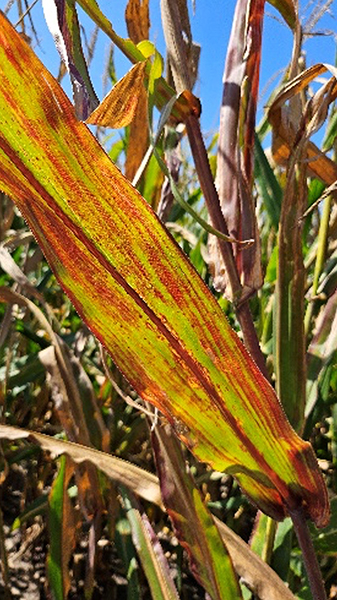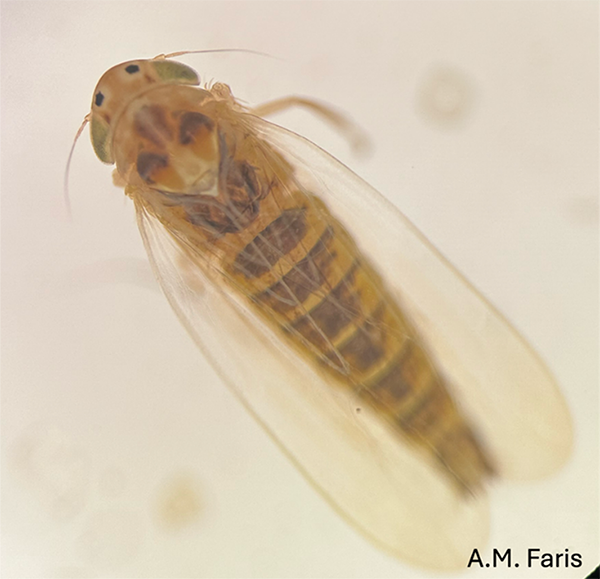Key Takeaways
Corn stunt disease and corn leafhopper were first reported in 11 new states in 2024 including Nebraska, Kansas, Oklahoma and more, marking a northward expansion of both the insect and pathogen.
Nebraska confirmed corn stunt disease in two Jefferson County fields and one Burt County field in 2024 but has not detected the pathogen yet in 2025.
Corn leafhopper presence has been confirmed in multiple Nebraska counties over two growing seasons, with continued monitoring underway.
Economic damage is unlikely so far because the pest and pathogen have arrived late in the season.
Management focuses on cultural practices such as early planting and volunteer corn control, as insecticide options remain limited and thresholds are still being developed.
A new corn pest is creeping into the Midwest, and Nebraska growers may soon have to contend with its arrival.
In 2024, corn stunt disease and its insect vector — the corn leafhopper (Dalbulus maidis), which transmits the pathogen — were reported for the first time in Oklahoma and Kansas. Scouting efforts in Nebraska intensified during the 2024 and 2025 growing seasons in response to these detections.
Eleven symptomatic corn samples from Nebraska fields were submitted for testing in 2024, with two Jefferson County samples testing positive by initial PCR tests for corn stunt. An additional sample submitted from Burt County, Nebraska tested positive for corn stunt spiroplasma (CSS) (by DNA sequencing analysis), one of the pathogens responsible for causing the disease.


Scouting for the corn leafhopper also expanded, leading to confirmation of the insect’s presence in late summer and early fall 2024 in Adams and Clay counties in southeast Nebraska, Burt County in northeast Nebraska, and Dawson County in central Nebraska (Figure 2).
Sampling during the 2025 growing season confirmed the presence of corn leafhopper in Kansas and, on Aug. 18, in a single field in Clay County, Nebraska (Figure 3). To date, CSS has not been detected in Nebraska this year.


Sampling data for 2025 is continuously updated in this online map.
The Bottom Line
So far, the arrival of corn leafhopper and the corn stunt pathogen(s) it carries has occurred late enough in the 2024 and 2025 growing seasons that economic damage in Nebraska is unlikely.
We encourage stakeholders to reach out to their local extension office and submit suspicious samples to the Plant and Pest Diagnostic Clinic if they suspect the presence of this disease or its insect vector in their fields. We will continue to monitor and update the sampling map.
Symptoms
The earliest symptoms of corn stunt disease are leaf yellowing (chlorosis) or reddening of leaf tips (Figure 1a). If plants are infected during vegetative stages, the stalk internodes may be shortened, causing plants to be stunted in appearance. Corn stunt disease may also lead to development of multiple ears or shortened, stunted ears, or the production of tillers.
Hybrid genetics and timing of infection can impact the symptoms and their severity, with infections starting later in the growing season generally being less severe. Symptoms may resemble those caused by several other crop issues, such as loss or damage to the ear, senescence of hybrids with high anthocyanin pigmentation, nutrient imbalances and/or drought conditions.
Some corn hybrids have a tendency to be discolored more than others due to natural plant pigments, making this disease difficult to identify and requiring laboratory confirmation.
Pathogen(s) and Vector
The corn leafhopper, Dalbulus maidis, is the only known pathway for transmission of corn stunt spiroplasma. This small (⅛-inch long), light brown-yellow insect can be distinguished from the many other common species of leafhoppers by the presence of two dark spots between its eyes (Figure 1b).
The corn leafhopper feeds on corn, preferring the whorl and shaded parts of leaves to eat and rest. This insect feeds by piercing the leaf surface and sucking up plant liquids. While very high numbers can cause direct injury through feeding and interfere with photosynthesis if their waste promotes the growth of sooty mold, it is their ability to transmit disease through the act of feeding that is of most concern.
Corn stunt disease can be caused by one (or a combination of) pathogens — mollicutes, spiroplasma, phytoplasma or viruses. Historically, Spiroplasma kunkelii is the most common causal agent initiating corn stunt in the southern United States. Corn stunt spiroplasma is efficiently transmitted by corn leafhopper and was confirmed in 11 new U.S. states in 2024.
It’s important to understand that not all corn leafhoppers are carrying the spiroplasma (or one of the other pathogens). The spiroplasma can be quickly taken up by the corn leafhopper when it feeds on infected plants and replicates within the insect, which the insect can transmit to new plants about two to three weeks later during feeding. Plant symptoms aren’t visible until about 30 days after the corn leafhopper transmits the spiroplasma, which travels to the actively growing parts of the plant, including roots, leaves, flowers, ears, etc.
Distribution
Native to Central America, the corn leafhopper has expanded its range south into Brazil and Argentina, where it can be a significant problem, and north into the southern United States, including Texas. In 2024, the insect advanced further north into the Great Plains, including Oklahoma, Kansas and Nebraska, likely due to changing weather patterns and cropping systems.
Management
Managing corn leafhopper populations is currently the most effective strategy for reducing corn stunt disease. Due to its very recent documentation in the Midwestern U.S., management plans and economic thresholds are still being developed for the corn leafhopper. However, there are some steps that can be taken:
- Early planting of corn can allow the plants to be at a more advanced stage by the time the insect vector and disease arrive, which should decrease impact on yield.
- Management of volunteer corn, particularly avoiding the presence of volunteer corn after harvest to remove potential overwintering sites for the leafhopper.
- Management of other residues — particularly grasses — in and around crop fields, although this approach needs further study.
Currently, chemical management is not considered to be an economically viable approach, as many insecticide active ingredients have not shown high efficacy against the leafhopper, and applications would likely need to be repeated frequently to have a significant impact on their populations.
There is some evidence that neonicotinoid insecticide seed treatments can protect early growth stages (up to V3) of corn; however, we do not yet know enough about the patterns of corn leafhopper populations in Nebraska to determine whether this is a critical window for this pest. Insect vector pest management is an area where we should be able to gain more insights as we learn more about the system in Nebraska and the Midwest.
More Information
- Please contact us in Nebraska Extension for more information.
- Submit samples to the UNL Plant and Pest Diagnostic Clinic and enclose a completed sample submission form
- See the Crop Protection Network multistate distribution maps for confirmed corn leafhopper and corn stunt pathogens. Additional resources are also available in a recent CPN webinar.
- For the latest Nebraska-specific details on corn leafhopper and CSS sampling, see this regularly updated Nebraska sampling map.

